Leie, Erich, born Leie, born on 10-09-1916 in Kiel, 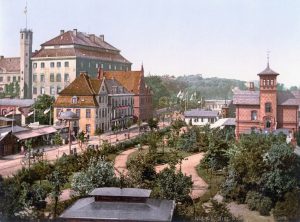 at the time in the Province of Schleswig-Holstein, a province of the Kingdom of Prussia.
at the time in the Province of Schleswig-Holstein, a province of the Kingdom of Prussia.
In August 1939, Leie temporarily led the Reservestaffel of Jagdgeschwader 71 Richthofen (JG 71—71st Fighter Wing)  until he was replaced by Oberleutnant (First Lieutenant) Horst Jacob Tietzen
until he was replaced by Oberleutnant (First Lieutenant) Horst Jacob Tietzen  on 29-08-1939 The Reservestaffel was a training squadron equipped with the Messerschmitt Bf 109 D-1,
on 29-08-1939 The Reservestaffel was a training squadron equipped with the Messerschmitt Bf 109 D-1,  under command of Oberst Theo Osterkampat the time based at Bad Aibling and subordinated to the I. Gruppe (1st group) of Jagdgeschwader 51 (JG 51—51st Fighter Wing).
under command of Oberst Theo Osterkampat the time based at Bad Aibling and subordinated to the I. Gruppe (1st group) of Jagdgeschwader 51 (JG 51—51st Fighter Wing).  under command of Oberst Theodor “Theo” Osterkamp.
under command of Oberst Theodor “Theo” Osterkamp.  who passed away on 02-01-1975 (aged 82) in Baden-Baden, Baden-Württemberg, West Germany. On 26 August, during the German mobilization phase, the Reservestaffel was ordered to Fürstenfeldbruck where it was tasked with providing fighter protection over Munich.
who passed away on 02-01-1975 (aged 82) in Baden-Baden, Baden-Württemberg, West Germany. On 26 August, during the German mobilization phase, the Reservestaffel was ordered to Fürstenfeldbruck where it was tasked with providing fighter protection over Munich.
World War II in Europe had begun on 01-09-1939 when German forces invaded Poland. On 21-03-1940, Leie was transferred to III. Gruppe (3rd group) of Jagdgeschwader 2 “Richthofen” (JG 2—2nd Fighter Wing),  named after World War I fighter ace Manfred von Richthofen “Red Baron”.
named after World War I fighter ace Manfred von Richthofen “Red Baron”.  He claimed his first victory on 14 May during the Battle of France when he shot down a Bristol Blenheim bomber 12 kilometres (7.5 miles) east of Sedan. By October 1940, Leie was serving with the Geschwaderstab (headquarters unit) of JG 2. On 28-11-1940, Leie was wingman of Major (Major) Helmut Paul Emil Wick,
He claimed his first victory on 14 May during the Battle of France when he shot down a Bristol Blenheim bomber 12 kilometres (7.5 miles) east of Sedan. By October 1940, Leie was serving with the Geschwaderstab (headquarters unit) of JG 2. On 28-11-1940, Leie was wingman of Major (Major) Helmut Paul Emil Wick, 
 Geschwaderkommodore (wing commander) of JG 2, on a mission to the Isle of Weight. Leie claimed a Supermarine Spitfire
Geschwaderkommodore (wing commander) of JG 2, on a mission to the Isle of Weight. Leie claimed a Supermarine Spitfire  fighter destroyed, his eleventh aerial victory. On that mission, Wick was killed in action when he was shot down, probably by Flight Lieutenant John Dundas
fighter destroyed, his eleventh aerial victory. On that mission, Wick was killed in action when he was shot down, probably by Flight Lieutenant John Dundas  of No. 609 Squadron. Almost immediately Dundas was himself attacked by Wick’s No. 2 and shot down after being chased out to sea. He was not seen again. His younger brother, Sir Hugh Spencer Lisle Dundas,
of No. 609 Squadron. Almost immediately Dundas was himself attacked by Wick’s No. 2 and shot down after being chased out to sea. He was not seen again. His younger brother, Sir Hugh Spencer Lisle Dundas,  also served in 609 Squadron and survived the war.He passed away 10-07-1995 (aged 74).
also served in 609 Squadron and survived the war.He passed away 10-07-1995 (aged 74).
On 23-07-1941, he claimed six Spitfires shot down in one day, an “ace-in-a-day” achievement, taking his total to 21 aerial victories. For this, Leie was awarded the Knight’s Cross of the Iron Cross (Ritterkreuz des Eisernen Kreuzes)  on 01-08-1941. He received the award from Feldmarschall (Field Marschal) Hugo Otto Sperrle
on 01-08-1941. He received the award from Feldmarschall (Field Marschal) Hugo Otto Sperrle  with fellow JG 2 “Richthofen” pilots Leutnant Egon “Connie” Mayer
with fellow JG 2 “Richthofen” pilots Leutnant Egon “Connie” Mayer 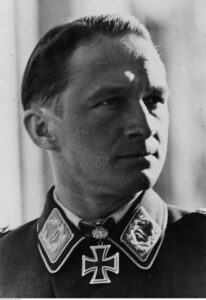
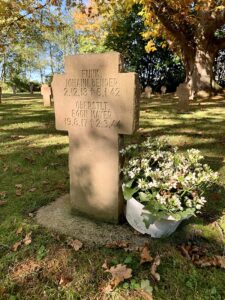 and Oberleutnant Rudolf “Rudi” Pflanz
and Oberleutnant Rudolf “Rudi” Pflanz  on that day. The triple award presentation was recorded by the Deutsche Wochenschau (German Weekly Review), a newsreel series released in the cinemas. By the end of 1941, his total stood at 32 aerial victories. His 32nd claim was a Handley Page Halifax heavy bomber
on that day. The triple award presentation was recorded by the Deutsche Wochenschau (German Weekly Review), a newsreel series released in the cinemas. By the end of 1941, his total stood at 32 aerial victories. His 32nd claim was a Handley Page Halifax heavy bomber  shot down on 30 December in the vicinity of Brest. On 26-01-1942, Leie claimed a Spitfire shot down south of Rame Head. The Spitfire was piloted by Kazimierz Kosinski
shot down on 30 December in the vicinity of Brest. On 26-01-1942, Leie claimed a Spitfire shot down south of Rame Head. The Spitfire was piloted by Kazimierz Kosinski  from the No. 302 Polish Fighter Squadron
from the No. 302 Polish Fighter Squadron  who was killed in action on a shipping reconnaissance mission that day.
who was killed in action on a shipping reconnaissance mission that day.
On 29-12-1944, Leie was appointed Geschwaderkommodore of Jagdgeschwader 77 (JG 77—77th Fighter Wing).  He replaced Major Freytag, Siegfried “Gustav” “the Lion of Malta”
He replaced Major Freytag, Siegfried “Gustav” “the Lion of Malta” 
 in this function who had temporarily assumed command after Major Johannes Wiese
in this function who had temporarily assumed command after Major Johannes Wiese 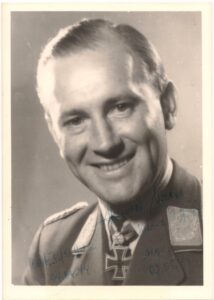
 was wounded in combat on 25 December. Wiese retired on 10-11-1970 holding the rank of Oberstleutnant. Wiese died on 16-08-1991, age 76, in Kirchzarten and was buried in Berlin-Nikolassee.
was wounded in combat on 25 December. Wiese retired on 10-11-1970 holding the rank of Oberstleutnant. Wiese died on 16-08-1991, age 76, in Kirchzarten and was buried in Berlin-Nikolassee.
Freytag continued to lead JG 77 until Leie’s arrival with the Geschwader on 15-01-1945. Command of his former I. Gruppe of Jagdgeschwader 51 was passed to Hauptmann Günther Schack.  Schack survived the war and passed away 14-06-2003, age 85, in Schmidt Germany.
Schack survived the war and passed away 14-06-2003, age 85, in Schmidt Germany.
On 12 January, the Red Army had launched the Vistula–Oder Offensive on the Eastern Front. The offensive required the Luftwaffe to relocate its forces, defeated Army Group A, taking much of Poland and striking deep within the pre-war borders of Germany. JG 77 was one of the first Luftwaffe fighter units ordered to relocate to the Eastern Front on 19 January.
As Geschwaderkommodore, Leie was ordered to Berlin on 22-01-1945 and attended the meeting with Reichsmarschall Hermann Göring  which was later dubbed the Fighter Pilots’ Mutiny. This was an attempt to reinstate Generalleutnant Galland, Adolf “Dolfo” Josef Ferdinand
which was later dubbed the Fighter Pilots’ Mutiny. This was an attempt to reinstate Generalleutnant Galland, Adolf “Dolfo” Josef Ferdinand  as General der Jagdflieger who had been dismissed for outspokenness regarding the Oberkommando der Luftwaffe (Luftwaffe high command), and had been replaced by Oberst Gordon Max “Mac” Gollob.
as General der Jagdflieger who had been dismissed for outspokenness regarding the Oberkommando der Luftwaffe (Luftwaffe high command), and had been replaced by Oberst Gordon Max “Mac” Gollob.  The meeting was held at the Haus der Flieger in Berlin and was attended by a number of high-ranking fighter pilot leaders which included Leie, Günther Friedrich “Franzl” Lützow,
The meeting was held at the Haus der Flieger in Berlin and was attended by a number of high-ranking fighter pilot leaders which included Leie, Günther Friedrich “Franzl” Lützow,  Johannes “Hannes” Trautloft,
Johannes “Hannes” Trautloft,  Hermann Graf,
Hermann Graf, 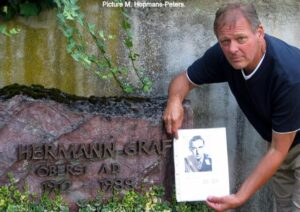 Gerhard Michalski,
Gerhard Michalski, 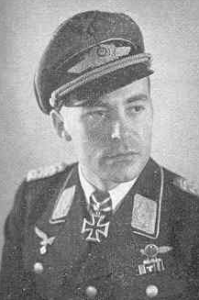
 Helmut Bennemann,
Helmut Bennemann,  Kurt Bühligen
Kurt Bühligen 
 and Herbert “Ihle” Ihlefeld,
and Herbert “Ihle” Ihlefeld, 
 and their antagonist Hermann Göring supported by his staff Oberst Bernd von Brauchitsch
and their antagonist Hermann Göring supported by his staff Oberst Bernd von Brauchitsch  and General der Flieger Karl Koller.
and General der Flieger Karl Koller. 
 The fighter pilots, with Lützow taking the lead as spokesman, criticized Göring and made him personally responsible for the decisions taken which effectively had led to the lost air war over Europe. Gerhard Michalski was involved in a motor vehicle accident on 22-02-1946 and died in a hospital at the age of 28 in Kaltenkirchen. His brother Werner was killed in action as a Leutnant on 10-04-1942 serving with Jagdgeschwader 26 “Schlageter”.
The fighter pilots, with Lützow taking the lead as spokesman, criticized Göring and made him personally responsible for the decisions taken which effectively had led to the lost air war over Europe. Gerhard Michalski was involved in a motor vehicle accident on 22-02-1946 and died in a hospital at the age of 28 in Kaltenkirchen. His brother Werner was killed in action as a Leutnant on 10-04-1942 serving with Jagdgeschwader 26 “Schlageter”.  Helmut Bennemann also survived the war and died Bennemann died on 17-11-2007 at the age of 92 in Bad Sassendorf. Oberst Bernd von Brauchitsch survived the war and passed away 19-12-1974 (aged 63) in West Germany.
Helmut Bennemann also survived the war and died Bennemann died on 17-11-2007 at the age of 92 in Bad Sassendorf. Oberst Bernd von Brauchitsch survived the war and passed away 19-12-1974 (aged 63) in West Germany.
Death and burial ground of Leie, Erich.

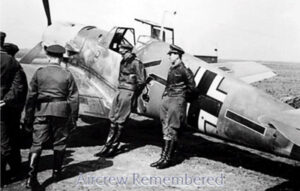

On 07-03-1945, Leie claimed his last two aerial victories and was killed in action. At 14:56, he claimed a La-5 shot down. Half an hour later, he claimed a Yakovlev Yak-9 fighter west of Bielitz, present-day Bielsko-Biała, but collided in mid-air with the crashing Yak-9 fighter in his Bf 109 G-14/AS (Werknummer 786329—factory number). He baled out at an altitude of 60 metres (200 feet), too low for his parachute to fully deploy. Posthumously, he was promoted to Oberstleutnant (lieutenant colonel), and nominated for the Knight’s Cross of the Iron Cross with Oak Leaves (Ritterkreuz des Eisernen Kreuzes mit Eichenlaub) ![]() which was not approved. Erich was buried at the German war cemetery Vojenský Hřbitov Valašské Meziříčí, Valasske Mezirici, Okres Vsetín, Zlin, Czechia. Valasske Mezirici, Zlinsky, Tsjechië.
which was not approved. Erich was buried at the German war cemetery Vojenský Hřbitov Valašské Meziříčí, Valasske Mezirici, Okres Vsetín, Zlin, Czechia. Valasske Mezirici, Zlinsky, Tsjechië.

















Leave a Reply